Furikake is a savory Japanese spice blend made with dried seaweed (nori), toasted sesame seeds, salt, and spices, typically used as a Japanese rice seasoning, but delicious on everything! Vegan & Gluten-free. Video.
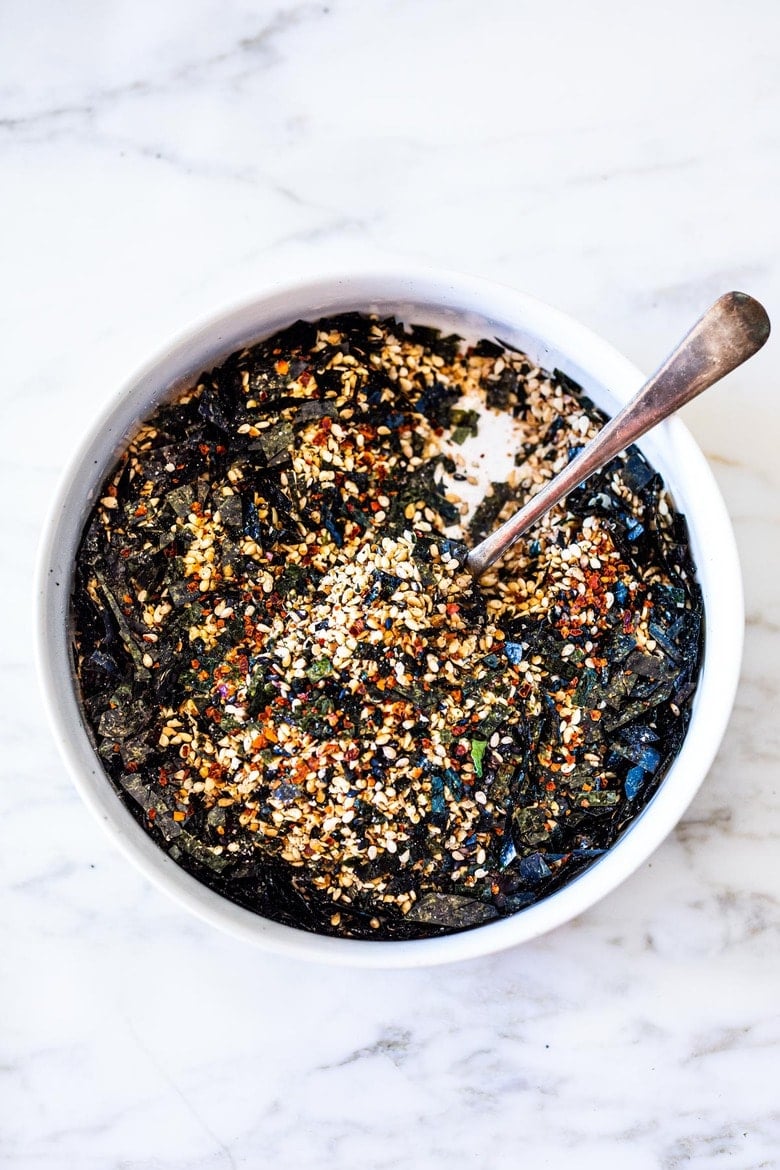
While traveling through Japan with my husband, we experienced the most incredible cuisine. Here is a recipe I brought back with me to share with you! This Furikake recipe is so savory and toasty! It’s a Japanese spice blend (or condiment) that is often sprinkled over Japanese Rice. But we’ve been using it on everything from Avocado Toast, to Poke bowls, to Poke Beets, to our Vegan Ramen! Lately, I’ve been sprinkling it over avocado toast and cucumber salads for the best flavor!
Recently a reader asked me how to make it because where she lived, it was nowhere to be found. These days it is pretty accessible in urban areas, easily found at most upscale grocery stores, Asian Markets, and even at Trader Joe’s! I really love this brand of Furikake! But if you, like her, would like to make it yourself, it is easy and doable!
Homemade Furikake would also make a beautiful hostess gift!
What is Furikake?
Furikake is a Japanese seasoning typically made with toasted sesame seeds, nori, salt, sugar. It varies from region to region and can also include anything from bonito flakes, to chili flakes to miso powder to shitake powder to poppy seeds. Some versions even include dried shiso leaves (another thing to do with your shiso leaves next summer).
Why You’ll Love This!
- Delicious topping for so many recipes! Furikake seasoning will instantly enhance any dish. It is so versatile and can be used in many ways- scroll down!
- Easy to make. Making furikake is as simple as toasting sesame seeds, mixing with crushed nori, and combining with salt and sugar. We also list a variety of optional add-ins that can take the flavor up a notch!
- Lasts a long time. Once made, this seasoning will store in an airtight jar for up to 6 months. You’ll probably go through it before then, but it’s great to know it won’t spoil anytime soon.
- It’s a great hostess gift. This is a fun and unique gift idea that people will love. Place it in a jar with a ribbon and use as the perfect gift for your next dinner party!
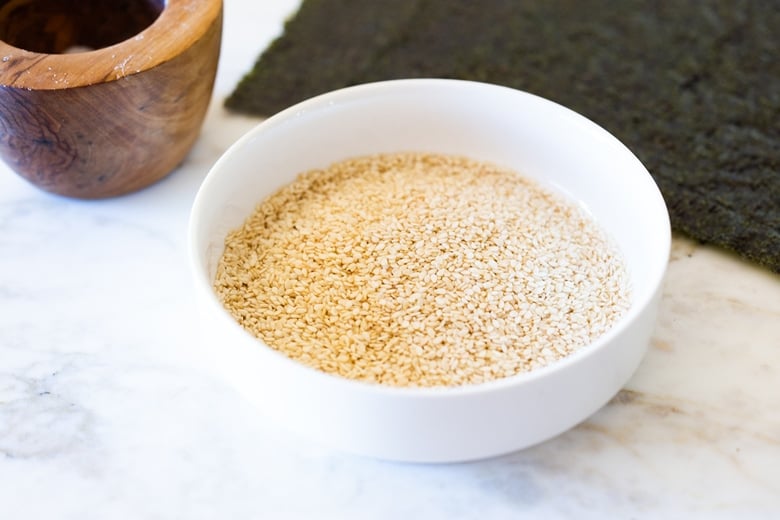
Furikake Ingredients
- White sesame seeds: Lightly ground and toasted to release their oil, adding a rich and nutty flavor to the seasoning.
- Nori seaweed sheets: Brings a distinct umami taste and sea-like essence to the blend.
- Salt: Enhances the overall flavor and balances the other ingredients in the furikake seasoning.
- Sugar: Adds a touch of sweetness to the blend, providing a pleasant contrast to the savory components. Optional, but good!
How do you make Furikake?
- Lightly grind sesame seeds to release their oil.
- Toast sesame seeds until fragrant and golden.
- Mix with shredded nori.
- Season with salt and sugar.
- Optional: Add chili flakes, bonito, dried shiso, shiitake powder or miso powder.
- Store in an air-tight jar for up to 6 months.
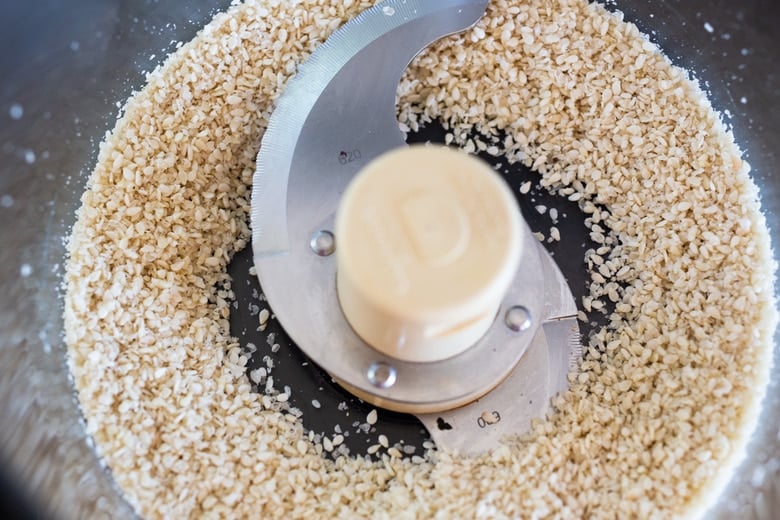
Lightly grinding the sesame seeds releases their oil, making them more flavorful when toasted.
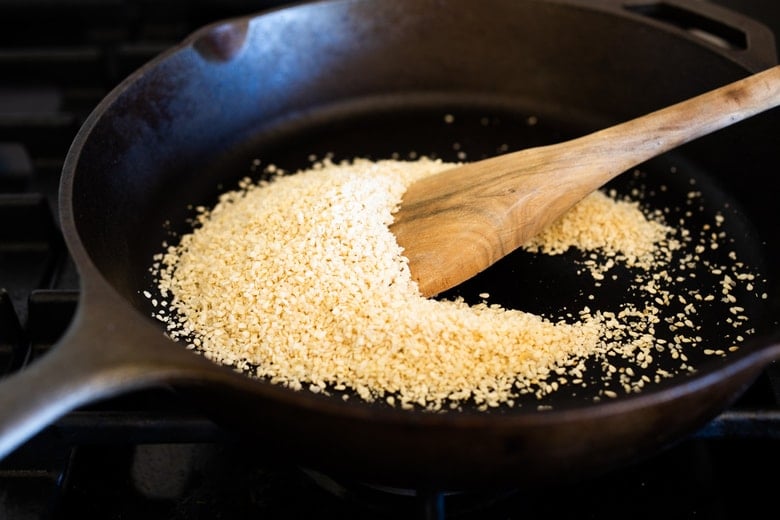
Toast until nutty and fragrant in a frying pan or cast iron skillet, stirring constantly over very low heat for 8-9 minutes.
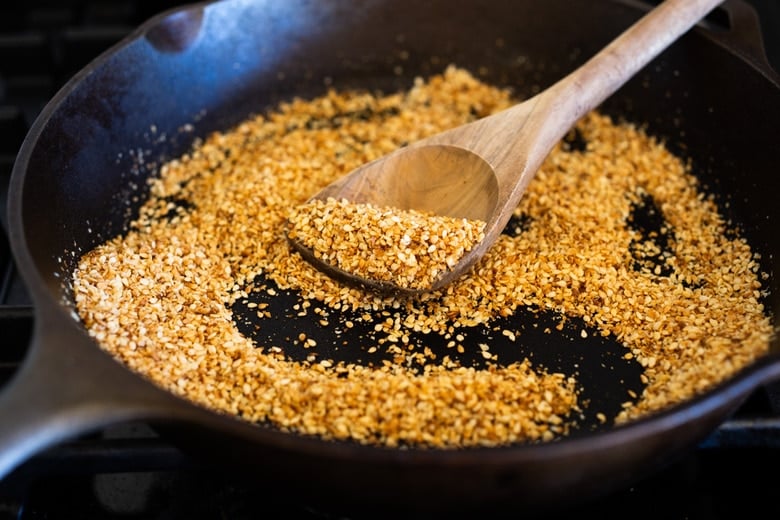
Shred, crumble or cut nori sheets.
To crumble nori sheets, tear into small pieces, then crumble with your fingers. Or cut with a knife or scissors.
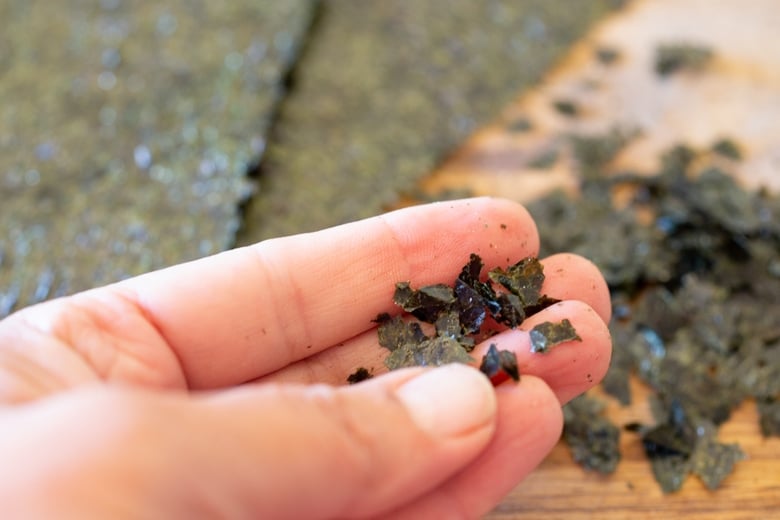
Stacking and folding the nori before slicing makes for faster and easier work.
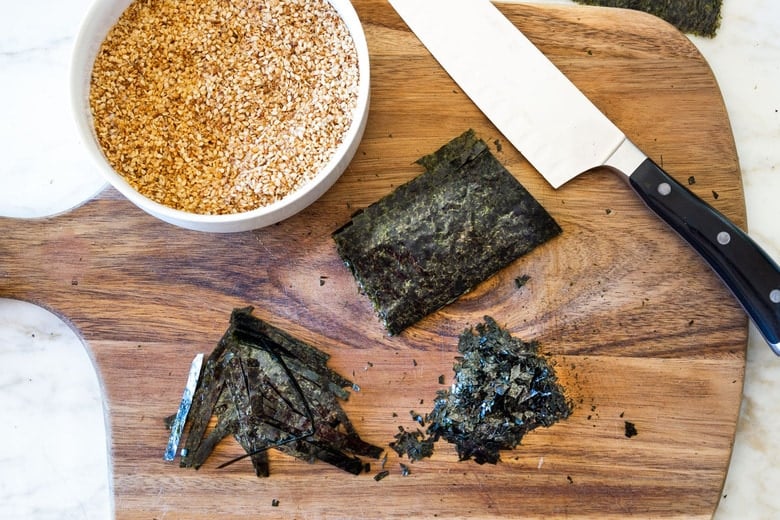
Then just mix everything together in a small bowl, adding salt and sugar.
Furikake Additions (all optional)
- 2 teaspoons shiitake powder (toast alongside sesame seeds in the pan)
- 1 tablespoon dulse (toast alongside sesame seeds in the pan)
- 1 tablespoon black sesame seeds
- 1-3 tablespoons bonito flakes
- ½ teaspoon wasabi powder
- 1 teaspoon kelp powder
- ¼ teaspoon red chili pepper flakes
- 1 teaspoon miso powder
- 2 teaspoons dried shiso leaves
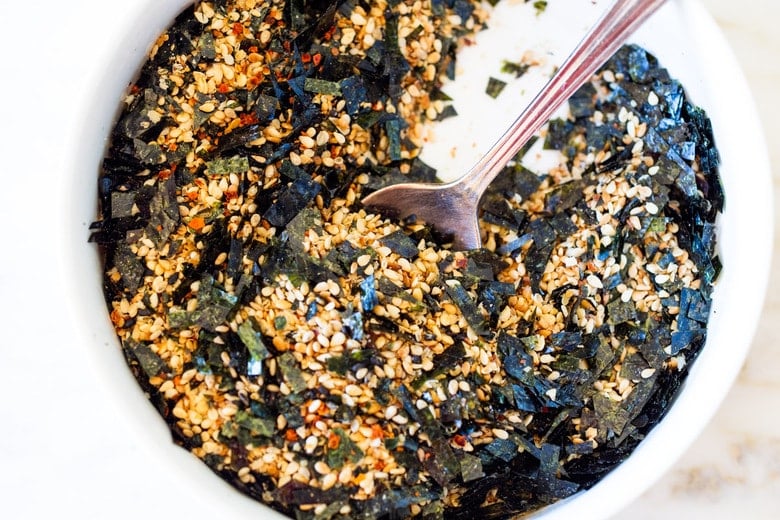
Storage
Once you make it, furikake seasoning will last for so long! Store in a sealed jar or airtight container for 4-6 months.
Ways to use Furikake Seasoning
There are many uses for this tasty Japanese condiment!
- Sprinkle it over white rice or rice balls.
- Top off Poke salad or poke bowls.
- Season a soft-boiled egg, a sunny side egg, or a scramble!
- Season Tofu with it.
- Sprinkle over noodles or ramen.
- Sprinkle over Miso Soup.
- Top off miso salmon or sprinkle over shrimp.
- Sprinkle on sushi or handrolls.
- Sprinkle on avocado toast.
- Dash it over a bagel with cream cheese and smoked salmon. (yum)
- Season Homemade Popcorn!
- Sprinkle it over a can of tinned fish, like sardines.
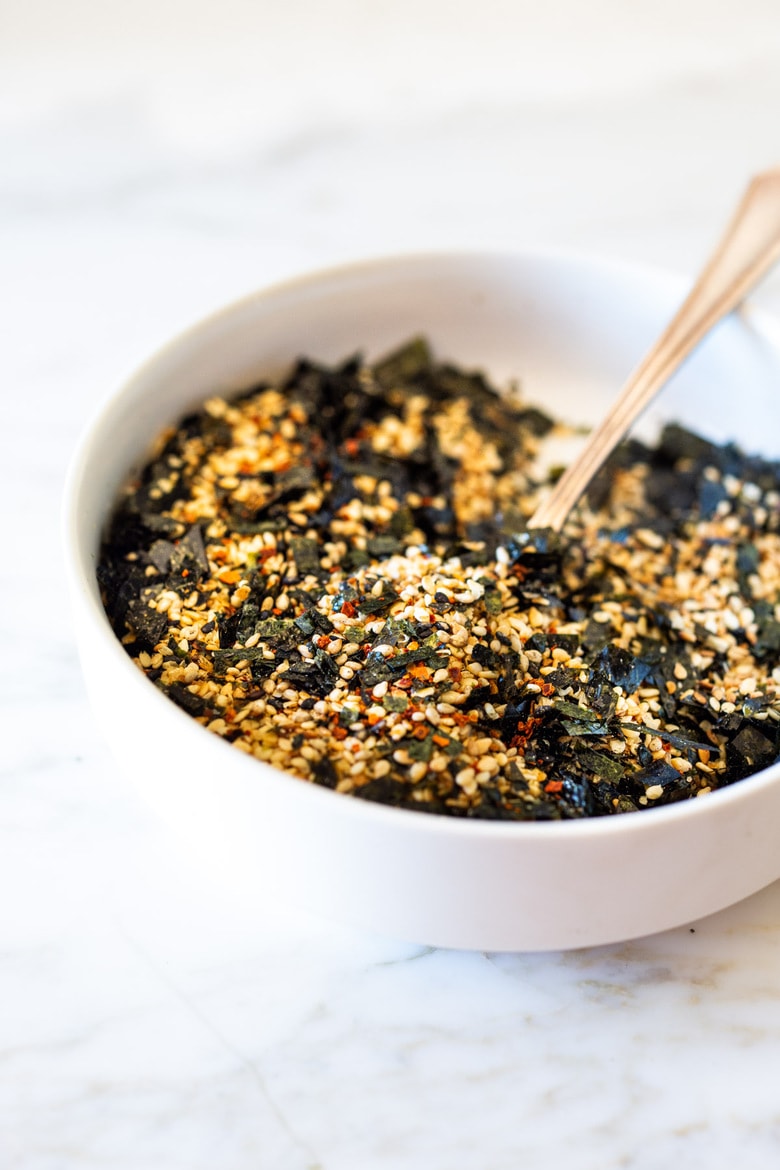
FAQs
This Japanese seasoning is traditionally made with toasted sesame seeds, nori, salt, and sugar. Though it varies region to region and can contain anything from bonito flakes to chili flakes to poppyseeds to miso powder or shiitake powder.
Yes! This seasoning is full of so many wonderful nutrients. It’s high in calcium, protein, iodine, iron, and other minerals. In fact, many vegans and vegetarians will add it to food as a nutritional supplement!
This seasoning has a crunchy texture and is salty with a touch of nutty flavor. It adds umami flavor to any dish!
Sprinkle your furikake seasoning over top of a finished dish right before serving.
Recipes that use Furikake Seasoning:
Hope you give this a try and enjoy!
Happy seasoning,
More from Feasting at Home
Watch How to make Furikake | 60-sec video
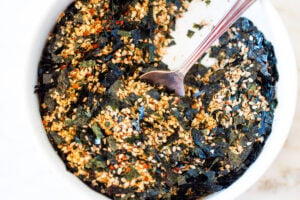
Furikake Recipe
- Prep Time: 15
- Cook Time: 5
- Total Time: 20 minutes
- Yield: 1/2 cup
- Category: spice, spice blend
- Method: toasted
- Cuisine: Japanese
- Diet: Vegan
Description
Furikake is a savory Japanese spice blend made with dried seaweed (nori), toasted sesame seeds, salt, and spices, typically sprinkled over Japanese rice, veggies, ramen, fish or avocado toast! Vegan & Gluten-free. Video.
Ingredients
Basic Furikake Base:
- 1/2 cup white sesame seeds (see notes)
- 2-3 seasoned nori sheets (or plain)
- 1/2 teaspoon salt, more to taste
- 1/2 teaspoon sugar (optional, but good)
Optional additions: (The proportions are just a starting point.)
- 2 teaspoons shiitake powder (toast alongside sesame seeds in the pan)
- 1 tablespoon dulse (toast alongside sesame seeds in the pan)
- 1 tablespoon black sesame seeds
- 1-3 tablespoons bonito flakes
- 1/2 teaspoon wasabi powder
- 1 teaspoon kelp powder
- 1/4 teaspoon red chili pepper flakes
- 1 teaspoon miso powder
- 2 teaspoons dried shiso leaves
Instructions
- In a food processor or spice grinder, pulse sesame seeds 1 or 2 times so that the seeds are partially ground, leaving some whole, taking care they grind quickly.
- Place seeds in a cast iron pan (or sauté pan) on low heat, stirring every minute or so until they become fragrant and lightly toasted, 7-8 minutes.
- Stack, fold and cut nori into small strips then cut into small pieces with a sharp knife or kitchen scissors, or you can also crumble with your hands.
- Add to sesame seeds in a small bowl, along with salt and sugar.
- Add any additional ingredients ( see ideas and get creative!)
- Store in an airtight container for up to 6 months.
Notes
Grind the seeds just a little – to better incorporate the salt, sugar and optional ingredients more evenly and help release the sesame oil.
The sugar is optional but gives a sweet savory balance.
Nori sheets – use regular, seasoned can add great flavor (wasabi, sesame oil, chili)
If using already toasted sesame seeds, no need to toast again.
Nutrition
- Serving Size: 1 teaspoon
- Calories: 18
- Sugar: 0.1 g
- Sodium: 48.9 mg
- Fat: 1.5 g
- Saturated Fat: 0.2 g
- Carbohydrates: 0.8 g
- Fiber: 0.4 g
- Protein: 0.5 g
- Cholesterol: 0 mg
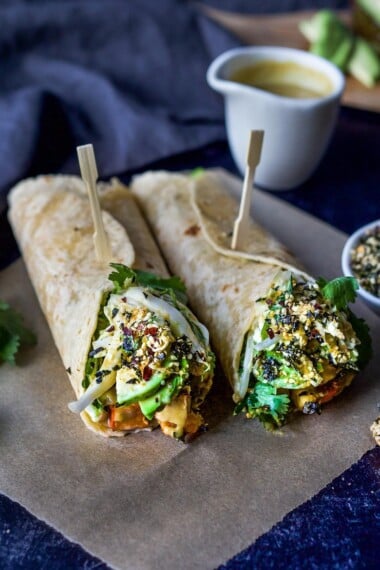
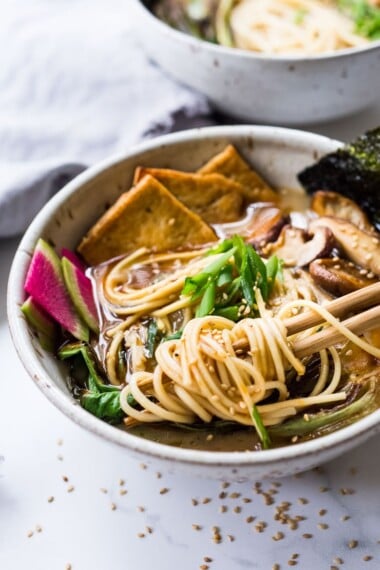
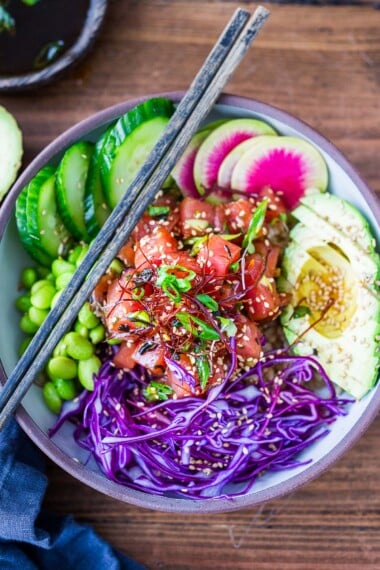
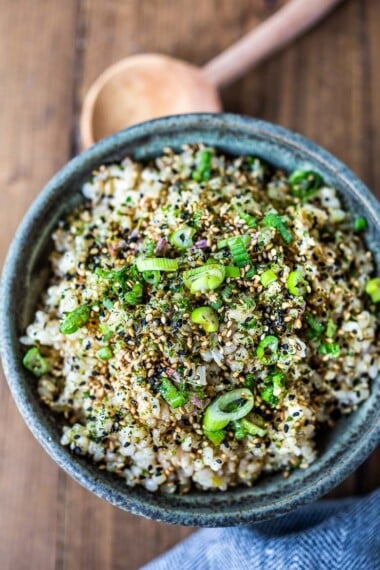


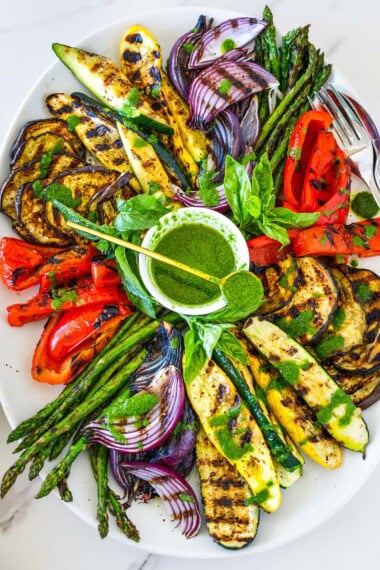

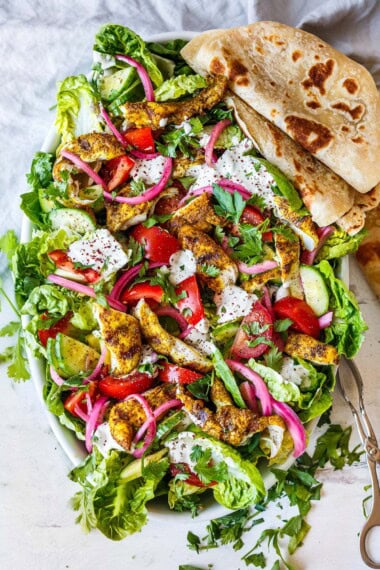

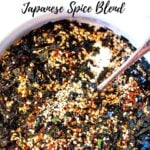
On which bottle?
Loved it!
Hi, I was wondering if you could make furikake with black sesame seeds instead of white?
Yes that works fine. Black seeds just have a slightly stronger flavor.
A simple, well balanced recipe that made my sushi casserole perfectly delicious! Why buy it, when it goes together so easily. Thanks so much.
Thanks Linda!
Very successful! Made the base recipe. Blended nori with sesame seeds in a small blender to save chopping it up, added salt, sugar. Unfortunately I can’t post a photo on here but mine looks like the original.
Yay! Great to hear!
Can you make one with orange peel
Orange peel is delicious added in! Start with a small amount as too much can make it bitter.
Excellent recipe, and delicious flavor. Thank you.
Glad you enjoyed Veronica!
Excellent flavors and visual appeal! I’m grateful to have a spice grinder, as I find nori to be quite challenging to chop with a knife.
Yes that seaweed is hard to wrangle but so worth it! Glad you enjoyed!
Loved this
Great to hear Suzette!
I do not add salt. The store bought furikake is way too salty. Nori sheets are salted. I would like to find unsalted nori.
Great Mimi!
My first attempt didn’t work out and I’m hoping you can help me troubleshoot. I remember having furikake in Japan and the nori flakes were very small, but I found that they do not crumble and even if cut it’s very hard to reduce them to small flakes. I even tried putting mine in the coffee grinder, but it didn’t work. This made me wonder if the Japanese perhaps fry their nori sheets lightly before crumbling them to make furikake?
The other issue I had was putting the sesame seeds in my coffee grinder reduced them almost to dust after just a few brief spins! So what I ended up with was sesame dust with some much larger jagged nori pieces sticking out of them!
Hopefully it will still taste good on rice. But I’m going to try and again and this time lightly fry the nori sheets before crumbling, and only spin the sesame once very lightly in my grinder.
Grinding the sesame definitely brings out a very nice fragrance from the seeds, but they are very delicate!
Hi Ross, Cutting the nori is probably the most time consuming part. I usually use scissors. You can also get the seasoned nori sheets that are sold as snacks, they are crisped in oil and crumble more easily. You could try just grinding some of the sesame so you have some whole and some ground. I bet it will still taste good, but I understand it was not what you were expecting!
Unfortunately I no longer trust Bonito or Asian seaweed products post Fukushima. What are the safer alternative ingredients to replace these with in the West ?
Yes, I usnderstand. I am honestly trying to figure this out myself. I have been trying to hunt down Atlantic seaweed – there is a brand called Main Coast Seaweed and I use their dulse- not sure what else they offer?
Thanks for the tip Sylvia, I will look into this.
I miss kombu dashi and other Japanese ingredients.
I wonder how hard it is to grow seaweed in a water tank or pool ?
I know there are radioactive issues regarding edible seaweed between the UK and Norway (nuclear waste spills into the North Sea and from West England into the Atlantic). Norway has officially complained to Britain over this issue several times.
As a substitute for mirin, I currently use Chinese rice wine and sugar, it’s close but not as light flavor as mirin. There is also a Korean drink called jinro (Original or plain flavor, not the terrible “fruit flavored” type), that also needs sugar to get the balance of mirin.
I still have not found a substitute for Bonito flake. That is a tough one.
It is a tough one!
Sylvia, it’s not via anger, it’s just plain old information for people to take or leave as they will. Food is vital to our health and wellbeing, it’s no joking matter. Look up the MIT Quaker Oats Radioactive Experiments and the court cases.
The problem with “humor” is that it reduces the serious impact of criminality and problems in general. Those that wilfully poison society are also laughing.
Sorry- I am not saying you are angry or that it is not serious. Just sharing a conversation my husband and I had recently. 🙂
Japanese food standards on permitted levels of radioactivity in products were already stricter than most in the West pre-Fukushima, and are even stricter since.
And you just believe them ?
With a little research, you soon discover that all global “food safety” agencies often look the other way when it pays well.
eg. The FDA often have somebody from (pro GMO) Monsanto on the board of directors, some would call that a conflict of interests. Monsanto denied for decades that their herbicides where causing cancer, they now have huge lawsuits against them as it has now been proven.
The State knew about the leaded drinking water in Flint Michigan for years, the toxic baby formula factories, asbestos in baby talc etc.
The “non gmo” butterfly logo is also no guarantee, the Naked juice brand display the logo but they knowingly used gmo, they were taken to court for it. The U.K. claimed their beef was safe when they knew it was not. Cochineal food color is “considered safe”, even though it is a proven carcinogen. Plastic food-wrap was found to cause cancer in rats in the 1950’s, but it’s “food safe”. etc…
I suggest you look these things up yourself, dig deep. There are public legal court records available etc.
The atomic industry is extremely corrupt, they will lie and cover up anything that gives them bad press. Their only goal is more nuclear stations, and they happily pay politicians to get what they want. Science and government institutions are not beyond corruption.
Just because Japan says “it’s safe”, that does not make it so. They were denying there was even problem, even though there was live footage of the explosions at the reactors. Recently, they even found an unexploded WWII bomb under the car parking area at Fukushima !
Fukushima will have hurt their exports trade. They need to convince people that “it’s safe” regardless of the truth.
Thanks David, your reply to AJ is spot on. The Japanese have eased ALL of their food standards when it comes to radioactivity. The people in Japan would have nothing to eat if they did not. 1/4 of their children have problems with thyroid disease from fallout, it’s a National tragedy, but their leaders look the other way. It’s always the common man and children that suffer. Sadly.
Hi Jaycee,
I remember Britain did the same thing after Chernobyl in the 1980’s. The UK government lied about the radioactive fallout in Britain, claiming “there was none”, (they also lied about Windscale, now renamed “Sellafield”, and Dounreay that leaked multiple times). But, in fact, they secretly monitored Chernobyl fallout in the UK for 25 years! It destroyed their lucrative meat export industry for many years. Followed by “mad cow disease” and then “foot and mouth” (easily cured with medication but they did not mention that fact), they were just scams to justify banks/governmental enforcement to mandatorily kill all the livestock in the country for insurance money, then buy new clean non-radioactive livestock.
Now I’m reading that scientists have engineered a “gmo chicken” ($patented$) to make them “bird flu resistant”, what effect will that have on people !?
Not only those eating the gmo chicken but also the eggs, or egg pasta, mayonnaise etc. They will force gmo frankenchicken by law, it’s how legal gangsters operate. You won’t be allowed to have a natural chicken without permits (already a requirement in Britain), if at all.
Our food quality is in serious decline, we are just lab rats at this point.
I grow as much of my own food as possible, I don’t buy processed food at all but, it’s getting harder to eat and drink healthily. I’m now seeing banned food additives suddenly being allowed by so called “food safety agencies” even when they know it’s not safe !
In general, “ingredient labels” are often very ambiguous (mysterious unnamed “spices” or “flavorings” etc., is it even the full list?), we only have their corrupt word for it.
“GMO free”, “fare trade”, “Organic” etc. but, is it really ?
If everybody refused to buy that toxic junk, they would not be able to sell it and then they would be forced to stop its manufacture as it would no longer be so profitable.
It is getting harder to find safe kitchenware too, everything is toxic plastic, toxic “nonstick” coatings (also a scam as you still have to use oil to stop food sticking to the pan), aluminium or silicon.
No wonder we now have all these new bizarre diseases and mental health anomalies in children etc. this past 40 years. Our real enemies are much closer to home than any foreign enemy is. I don’t get why people are ok with this.
Problem is that cancer is very profitable. Big pharma is laughing all the way to the bank either way.
Hi David- I understand your anger and agree with you. I, like you, feel anger and outrage especially surrounding our food, and how big pharma’s success is based on people being sick. But my husband told me something once- that I’ll never forget. You can’t change someone’s beliefs through anger or outrage,it will just create a barrier. It’s much easier to use humor. If you can get someone to laugh about something, they might be more inclined to listen. Just thought I’d share. 🙂
Hey! Would you recommend storing this in a freezer or fridge? Also if I’m making a single serving twice a week or so, how long will this last me? Thank you for the wonderful recipe by the way!
Hi Molly, I like to store this in the fridge, though the freezer is fine too. There are about 8 tablespoons (1/2 cup) per recipe so maybe a month or so depending on how much you like to use!
Ok, going nuts here. I have just made your Furikake and it is so flavorful. I had to use my seaweed snack sheets and I don’t have any sesame seeds, but will get both the nouri sheets and the sesame seeds today. I just want to make everything it all looks so good! The seasoning, red enchilada sauce, and the sourdough starter (in the process of making – hope I don’t ruin it) are just fantastic! I will be putting this seasoning on everything! Finally…I feel like a good home cook in the making.
Amazing Rita! Love it all. I actually prefer the seaweed snack sheets but addicting either way!
My local Grocery Store does not carry this seasoning pre bottled but they sell Nori sheets and Sesame seeds black and white ones witch for me is good I like to make everything myself when I can and this is such a simple recipe but can really give you some great flavor for Rice Sushi or what ever you may decide to use this on Thanks for the Idea’s gonna try a different one tonight when I make my spicy tuna bowl…
Thanks Gary!
would black sesame seeds work here too? Thank you.
They definitely add to the mix though not in place of the white sesame seeds.
I totally agree not only color but they part some flavor too bonito flakes is a good option too for a little added flavor
I will be trying this! What is the recommended shelf life?
4-6 months. But it may not last that long!😉
Thank you so much for posting this! I looked into a brand of the seasoning and it had some types of additives; I just cannot stand to use something with those!
I just found out about sushi bake and needed furikake for that, but I will def use your ideas for other recipe toppings, as well as adding additional ingredients, like bonito, etc.
Aloha!
It’s not vegan if you use bonito flakes
The basic recipe is vegan. We list the bonito flakes under the optional ingredients to give you ideas so you can adapt to make your own desired version. 🙂
Just made this recipe, it came out amazing! Thanks!
So delicious and part of the fun is the flexibility of ingredients and making a blend yourself instead of paying for a tiny jar at the store.
yum! so good and quick to make. love all the adaptation options.
I added dulse, shiitake powder and red chili flakes…
so rich and delicious. I keep finding many things to eat it on!
thanks for all your inspiration. LOVE your recipes.
thanks so much and so happy you are liking it!
I don’t think you should be calling this recipe vegan as you added bonito (dried tuna) flakes to the mix. Maybe leaving the bonito as an optional item would allow you to call the recipe “vegan friendly” but as it stands, this isn’t a vegan condiment.
I did not add bonito- it is optional 🙂